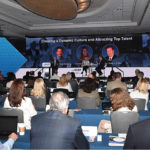
Photo by Jimmy Hamelin
The main purpose of Convene’s recent media trip to the City of Saints, sponsored by Tourisme Montréal, was the fourth annual C2 Montréal conference, which was held on May 26–28. Formerly called C2MTL, this business conference explores the intersection of creativity and commerce while pushing the boundaries of the typical meeting experience. Also on the agenda were an afternoon tour of the city’s vibrant and diverse neighborhoods on arrival day and return trips to a few of them for some memorable meals throughout our four-day stay.
IN CONSTANT FLUX
Our home base was Zero 1, a 120-room boutique hotel with a hip, industrial ambience that’s within walking distance of the Palais de congrés de Montréal convention center. Rain turned our small group’s scheduled walking tour into a car ride, which made the fact that Montreal sits on an island in the Saint Lawrence River all the more clear. We drove over a bridge to Parc Jean-Dreapeau, made up of two small islands — one of which, Île Notre-Dame, was in the home stretch on preparations for June’s Grand Prix Montreal race.
We circled back through Montreal’s modern central business district. Mount Royal, the low-slung mountain rising in the heart of the city, was never far from view as we crisscrossed the city. When the rain let up, we set foot on McGill University’s beautiful, leafy campus, walked the cobblestoned streets of lovely, historic Old Montreal, and explored the surprisingly vast Underground City — a year-round subterranean transportation, shopping, hotel, and restaurant complex.
I finished the tour with the sense that Montreal is in constant flux, comfortable with its juxtaposition of the old and the new. That night, we dined at Le Locale in Old Montreal, where the restaurant’s concrete, steel, brick, and glass décor — and classic French cuisine, freshly interpreted — was likewise a satisfying mix of rustic and modern.
REINVENTING INVENTION
The next morning, we headed to C2 Montréal, housed in the Arsenal, a rehabbed shipyard in the Griffintown neighborhood. The formerly desolate industrial area has been in the midst of a revitalization campaign, and in the three years since I attended the inaugural C2MTL, remarkable progress has been made. Griffintown still has a gritty façade, but it’s decidedly hip. Cafés and shops have popped up, and technology and creative startups have put down roots in historic warehouses and industrial buildings.
I was among the 45 percent of attendees who had been to a previous C2 Montréal, so I wondered: How does a conference on innovation reimagine itself every year so that it feels new? The answer, apparently, is to start from scratch. The one constant with each year’s program is a laser focus on the participant experience, which is considered in terms of taking a journey. “Audience engagement” has become a buzzword in the conference industry, but C2 Montréal organizers push beyond that to create an immersive environment, achieved through thoughtful design and painstaking attention to detail.
That was evident the moment attendees entered the Arsenal and were greeted by a colorful patchwork of reclaimed doors, stacked next to each other three levels high to form an entryway wall. It was a visually arresting cue for this year’s theme of choices, and how we make them as consumers, citizens, and business leaders.
A variation on that theme — where to go from here? — assaulted us as we entered the dramatically lit main hangar area. The vast space was carved into myriad sections and interactive art installations. With walls built of unfinished wood and three levels of scaffolding containing lounges and seating, the staging felt under construction, and underscored a sense of creation in the making.
Throngs of people — 5,000 participants this year — made their way through the interactive constructs and experiences that challenged not only the traditional exhibit hall but, in some cases, gravity. A grouping of chairs in a net, suspended 18 feet above the main floor, gave participants the opportunity to brainstorm while feeling physically at risk; in the Cloud of Fog, participants experienced a workshop without being able to see each other; and when they climbed a ladder to get inside a massive glob of branches called The Nest — created by C:Lab, the creative laboratory of Cirque du Soleil — an interactive exercise awaited. Behind the soaring and bustling Arsenal, participants were transported to an outdoor village circus, complete with a big tent and Ferris wheel, and rimmed with food “trucks” made out of colorful, stacked freight containers.
The overall effect of the environment, Jean-François Bouchard, CEO of the Sid Lee creative agency and curator of C2 Montréal, told Convene, was “deliberately overwhelming,” requiring reflection and deeper thought. Look for us to unpack the experience — and a number of the conference’s initiatives — in upcoming issues.




